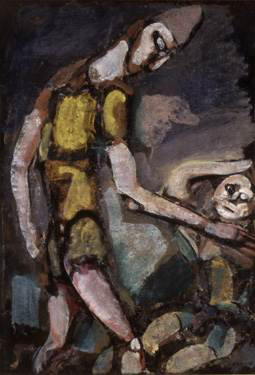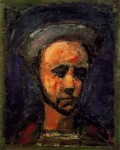
Georges Rouault
French, 1871-1958
Clownerie, 1917 ca.
gouache and oil on paper marouflaged to linen
40 1/4 x 28 1/2 in.
SBMA, Bequest of Wright S. Ludington
1993.1.7

The Workman Apprentice-Self Portrait, c.1925, Georges Roualt, oil on paper laid down on canvas,The Estate of the Artist, Private collection.
“The artist discards all theories, both his own and those of others. He forgets everything when he is in front of his canvas. “
- Georges Rouault
RESEARCH PAPER
The Georges Rouault we encounter in the painting, Clownerie, is distraught with the evil of war. In 1914 he had plunged into an artistic meditation of engravings, War and Miserare, to summarize the sufferings and hopes of contemporary man. During this period, he did very little painting. Perhaps for this reason, these works are doubly important.
During this time, he adopted oils as his preferred medium to express himself in color, a change from his earler choice of watercolor, gouache and ink. Two reasons are suggested for this development. His emersion in printmaking had given him a taste for a technique that allowed for second thoughts, for reworking his colors. Also, experiences in ceramics with glowing enamels had stimulated his desire for deeper, richer tones and a depth of texture that could be manipulated as part of form. In Clownerie he dramatizes his figures with pungent yellows and glowing greens, modulated by the pale peach tones of their flesh, also splashed into the background, and the ever-present blacks.
He returned to the theme of the circus. His Old Clown, also a 1917 work, ashen-faced as a death mask, is greatly admired as one of Rouault's most important work. Santa Barbara's Clownerie intertwines two buffoons with pasty faces, engaged in a macabre-style interplay, one elongated figure with a lean face, the other seated, round-faced, recoiling as a victim might. There is no real identity in their faces, no detail to particularize the setting. No foreground separates them from the viewer, so that the spectator can be drawn into their conflict and their pain.
The earlier more frenzied lines of his watercolors are replaced with a new serenity. His brushstrokes are supple and strong, mastered by the power of this mind as builder and organizer. The artist's anger is diffused. Bernard Dorival in his 1983 biography of Rouault calls this time a period of Stoicism. He parallels Rouault’s lifetime development with the passage of Dante through Hell (1902-1914), then Purgatory (1914-1930), to Peace (1930-1948) and Joy (1948-1958). Rouault, deeply committed to his Catholicism, could never divorce his art from his renunciation of sin and the quest for spirituality and redemption.
After the recluse years of his focus on Miserere, as the engravings were eventually named, a retrospective exhibit in 1920 of Rouault's work evoked this commentary in Bonsoir (Nov. 16, 1920) from critic Gaston Varonne: "What is generally called religious art resembles Rouault's work as little as a prayer learned from a book resembles a cry that goes clearly from the heart to God."
ABOUT THE ARTIST
Born in the Commune in Paris of 1871, Rouault was strongly molded by a working class mistrust of the bourgeouisie. His father was an artisan and his aunts painted vases and fans, but his closest relationship was with his maternal grandfather, a postal worker, who read Goethe and Hugo and bought Daumier lithographs that were much admired by the young George and a pervasive influence on Rouault's art as social commentary.
At 14, Georges apprenticed to two stained-glass makers and had the opportunity to work with some antique glass. "I lived most of my lunch hours there in front of those old windows. The hour was heaven to me." he wrote. Their colors echoed in Rouault's works as well as their elongated forms and frontal presentations. Rouault's outlining is often credited to this influence, but more likely it was his admiration for Cezanne's defining line. Actually, the pure colors were more characteristic of the other Fauve artists with whom he launched his early career in the 1905 Salon des Independants as Rouault chose more somber tones.
Roualt had entered the Ecole Nationale Superior des Beaux-Artes in 1892 and became a favorite student of Gustave Moreau. Although he steeped his pupils in the great masters, he urged them "to become themselves" and to develop an "imagination for color" to translate their spiritual lives into beautiful objects. These principles inspired Rouault all of his days.
After the death of Moreau in 1898, Rouault plunged into the world of 19th and 20th century art. With his friend Matisse, he drew not only the thick impetuous line from Cezanne, but the magic of watercolor and the color blue. Watercolor suited Rouault to convey his explosive emotions in an eruption of color, contained with lines that snarl in tangles and dash across the page in sure strokes and arabesques, supplying the work with rhythm and cadence. Rouault used chiaroscuro consistently, not to create a sense of space or a third dimension, but to express the emotional feel of his work. In this way he is compared with Rembrandt.
At this time, he also experienced his deep conversion to Catholicism. Because he had a distaste for traditional religious art and an admiration instead for the expressiveness of Grunewald's Crucifixion, he explored new forms to contain the struggles against evil and his search for redemption. Like Toulouse-Lautrec, Rouault used prostitutes for models, but his were expressionless and naked, dissolute of spirit, victims of society. The clown he saw as a symbol of Man, draped falsely in rich attire, who must maintain his role in life's circus and must not cry. "I clearly saw that the buffoon was me... that he was all of us."
Despite the Fauve showing, Rouault remained outside the avant garde, who moved to geometricize forms and put aside reality. Indeed his commitment to social and religious themes left him out of the mainstream of 20th century art. A family man, he was married to Marthe Le Sidaner, a pianist, who gave lessons to help support their four children. His Catholicism had little appeal to the contemporary intellectual. He remains an isolated figure today.
Finally came the periods Dorival ascribes to Paradise - first peace as recogniition brought acceptance and then the final years of calmness and joy until his death at age 86 while the artist still explored a new luminous palette. His work was lightened with flowers and spiritual landscapes and with hope-filled icons as Veronica and the Holy Countenance, interpreted by Rouault as the sweet gifts of his Saviour's presence, offered in the midst of the Passion.
Prepared for the Santa Barbara Museum of Art Docent Council by Shirley Dettmann, April 21, 1993
SBMA Docent website 2008, LG.
Pierre Courthion, Rouault, page 197
Bernard Dorival, Rouault p. 59
Dorival, p. 9
Dorival, p. 47
Rouault, letter to Edouard Schure, 1929

Undated photo of Rouault.
